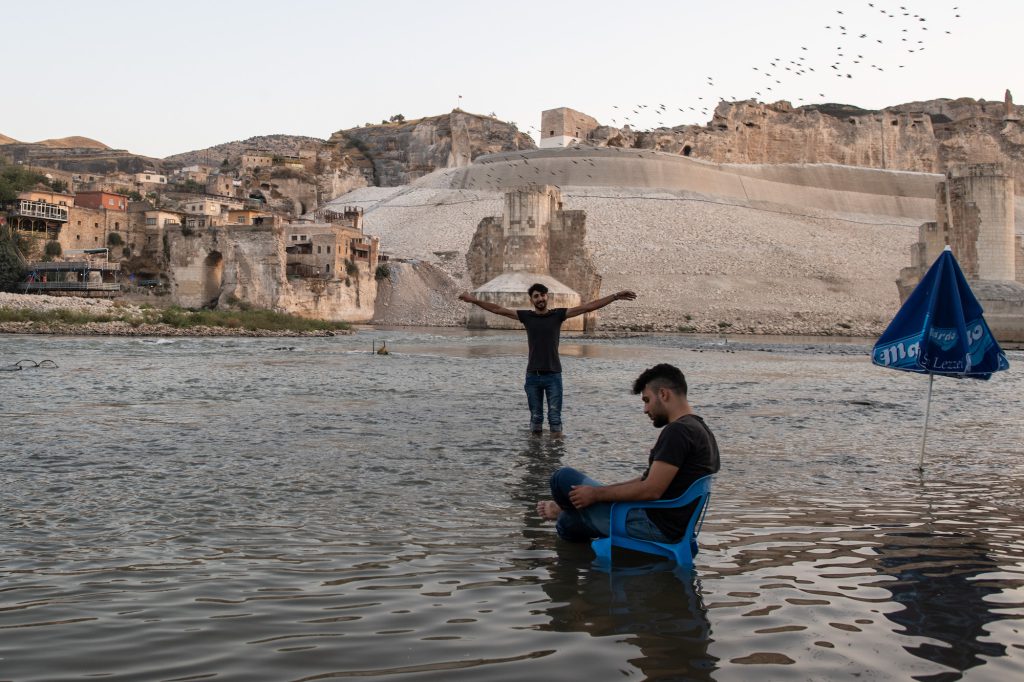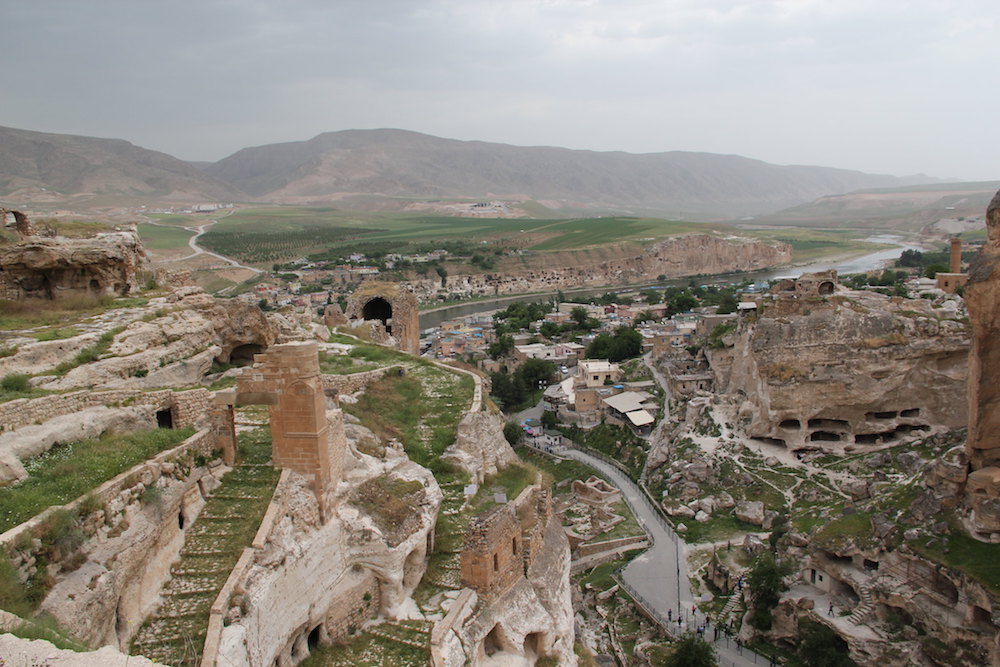The UNESCO Site That Never Was

In some of Zeynep Ahunbay’s earliest memories of southeastern Turkey, birds fly high above the town of Hasankeyf’s crumbling stone citadel. In one long, panoramic look, the conservation architect could take in an expanse of history, from the ancient stairs cut into limestone cliffs to the cluster of rickety cafes on stilts above the winding Tigris River.
When Ahunbay and her husband, an archaeologist, arrived in the early 1980s, Hasankeyf was a jewel. Life in the small town seemed to have barely changed over the centuries. Once a popular stopover on the Silk Road trade route, Hasankeyf saw minimal development between the 17th and 19th centuries. “So, what do you have? You have pure history,” Ahunbay says.
For more than a century, Hasankeyf offered scholars a window into 12,000 years of human occupation. Residents—claiming a blend of Arab, Kurdish, and Turkish descent—still point to the surrounding caves, where their ancestors were born and which some locals continued to inhabit into the early 2000s.
In the last few months, however, Hasankeyf has become a city under water. The waters of the Tigris overflow into abandoned neighborhoods, shops, and family orchards. In July of last year, the Turkish government activated the hydroelectric Ilisu Dam on the Tigris River, one of several installed as part of a multi-decade infrastructure plan for southeast Turkey.
Once complete, the reservoir’s surface area is expected to reach 121 square miles. It will cover the habitat of several rare or endangered species, and dozens of villages and small towns, including the better part of Hasankeyf.
Activists fought the Ilisu Dam for decades. Their concerns included the archaeological and environmental losses, and the people of the region’s wellbeing.
The reservoir cuts across routes used by some of the last nomadic shepherding communities in the region, for example. And the area lies in Turkey’s southeast, where the nation’s Kurdish people—the country’s largest ethnic and linguistic minority—are concentrated. The majority of residents uprooted by the dam project are Kurdish, and the waters cover several sites deemed significant to Kurdish culture and history.
In response to its critics, the Turkish government argued that the project is crucial to developing the country’s relatively impoverished southeast. “The nostalgia of living [here] may be romantic,” the Ministry of Foreign Affairs wrote in a statement. “But it does not address the social and economic needs of the region.”
Turkey has an abundance of historically significant places—the longest list of potential UNESCO World Heritage Sites in the world. To preserve each one would be impractical. And so, the loss of Hasankeyf can offer a case study into the difficult calculus that informs what societies choose to preserve or destroy.
Large dams are demonstrations of innovation and political might. They are long-term, capital-heavy projects that provide hydroelectricity to growing populations and irrigation for agriculture. They allow governments to contain and control the rivers within their borders.
At the same time, dams swallow up ecosystems, historical monuments, and human settlements—often communities with fewer resources and less political sway than their neighbors. This tradeoff has been demonstrated around the world. The Three Gorges Dam in China inundated 1,208 known archaeological sites and displaced more than 1.1 million people by 2012. In India, the filling of a dam reservoir in 2019 forced tens of thousands of Indigenous people from their homes near the Narmada River.
In Turkey, large-scale dam projects have been a political priority since the Turkish republic’s founding in 1923, says Akin Unver, an expert in international relations at Kadir Has University in Istanbul. The issue transcends both party and politics. Unver notes that dams have flooded many towns over the years. Hasankeyf is merely the latest.
The dam will displace at least 15,000 people, according to the government—activists estimate it will be closer to 78,000.
Still, activists have argued that the town’s cultural heritage sets it apart. Archaeologists believe humans have settled the area of Hasankeyf since at least the 10th millennium B.C., when our species began to domesticate wheat in southeast Turkey. For example, a mound excavated near Hasankeyf revealed the remains of stone houses, obsidian arrowheads, and human burials from about 11,500 years ago.
Later, Hasankeyf grew into an important trading and textile production hub on the Silk Road. It was the final stronghold of the Ayyubid dynasty of Saladin, a Kurdish Muslim ruler whose domains included parts of Syria, Yemen, and Egypt.
In prosperous times, Hasankeyf’s rulers boasted of their power through investments in art and architecture, many of which have survived into the present day. The impressive Er-Rizk mosque, for example, dominated the skyline until authorities moved it to higher ground this winter. “It’s a masterpiece of craftsmanship,” says German building archaeologist and architectural historian Peter Schneider, of the Brandenburg University of Technology.
Many of these sites hold special significance for the Kurdish people. Between Hasankeyf and its surrounding villages, Turkey’s Ilisu Dam will ultimately displace at least 15,000 people, according to the government—but activists estimate the number will be closer to 78,000. Many of these residents are Kurds, a fact led critics in the 1990s to question whether anti-Kurdish sentiment motivated the government’s plans.
The Turkish government has repeatedly denied this suggestion. Nonetheless, says Djene Bajalan, an expert in Kurdish history at Missouri State University, “the notion that this economic project is an assault on a symbolic aspect of Kurdish culture holds a lot of weight among Kurdish people.” The government, he says, has “tried to demonstrate that the Kurds don’t have a history.”
Locals, archaeologists, ecologists, and the Kurdish diaspora have fought the Ilsiu Dam intensely. At one point, they hoped the site could be saved as a UNESCO World Heritage Site. (It meets multiple criteria for UNESCO nomination, activists claimed in a petition that garnered over 13,000 signatures last year.)
But only a national government can propose a site to UNESCO. From the Turkish government’s perspective, Unver says, “the people of the region will benefit from the dam far more than from the financial spillover of it being a UNESCO World Heritage Site.”
Other efforts to save the town have focused on engaging the international community. For example, activists brought their concerns to the European Court of Human Rights with the hope of protecting Hasankeyf. In February of 2019, however, a chamber of seven judges rejected that application and sealed the town’s fate.
In preparation for sinking Hasankeyf, contractors built a steep rock harbor around the citadel, cutting it off from the community below. For determined local teenagers and the occasional tourist, it’s not difficult to scramble up over the white stones to reach the top.
From there, it’s possible to take in the scope of the dam’s consequences. Standing on a ledge in the citadel, one can see a collection of identical, sand-colored homes in the distance, reminiscent of a suburb in the United States. The government built these houses of “New Hasankeyf” for the former town’s residents. But the structures are fraught with leaky ceilings, cracked walls, and unfinished electrical wiring.
Some residents say they have reached a level of acceptance with Hasankeyf’s future. They hope they can find work in a new tourist economy that will rise around the lake. They make dark jokes about learning how to scuba dive. “Of course, everyone is sad,” says lifelong resident Ugur Ayhan. “But there’s nothing to do anymore.”
For preservationists like Ahunbay, the pain is too deep to permit even a last visit to say goodbye. “We were not able to stop the vandalism,” Ahunbay says. “[But] these feelings will maybe tell the future generations that the place was loved and treasured.”
Even in Hasankeyf’s final days, it continued to yield archaeological secrets. As a construction crew prepared to relocate the historic Er-Rizk mosque in November 2019, they uncovered stone foundations below the town bazaar. Rescue archaeologists set to work, but they could only do so much before the waters arrived.



































